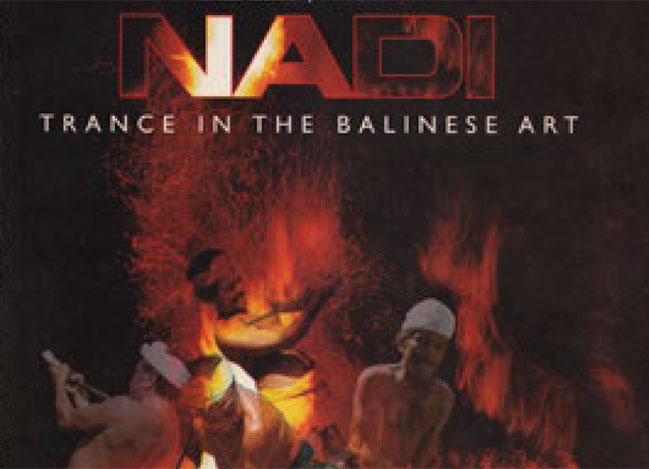Nadi Trance in the Balinese Art
Trance — called kerahuan in Balinese, which means ‘a state of being entered’ — is thought to be the influx of another energy into a person’s body, which takes over control of the body and causes a change (or loss) of consciousness. Kerauhan is often found in traditional Balinese art performances, ranging from the strictly sacred to the secular performing arts. Sanghyang is an ancient sacred dance ritual that always brings an element of trance. In Sanghyang Jaran (horse sanghyang) a man in trance rides a hobbyhorse barefoot in glowing coals as if he were playing in a puddle of rainwater. Sanghyang Celeng (wild boar) charges here and there swallowing objects that are considered to be the source of an outbreak of disease.
Trance often occurs in the semi-sacred dance drama Calonarang. It normally takes place at the climax of the battle between the Barong (a benevolent dragon-like effigy) and his nemesis Rangda (a demonic witch figure). Rangda is attacked by a crowd of men with raised keris daggers. Her power turns the daggers against the men so that they stab themselves wildly, while the power of the Barong prevents the daggers from piercing their skin.
Almost everyone who experiences trance, whether performers or spectators, say that it is difficult for them to recount what happens when they are in this altered state. Rangda dancers say that the power of the mask is so great that they remember nothing. Marks from the keris daggers are not at all painful. Nor does the Sanghyang Jaran dancer feel the heat of the coals.
Most trancers report only feeling a little tired afterwards.
The book Nadi: Trance in the Balinese Art by a group of mostly Balinese authors attempts to describe how Balinese experience trance when they are erforming their traditional arts — how kerahuan occurs at the moment when a sacred energy arrives in a performance. The term nadi, according to one source, refers to “the opening of the Third Eye of spiritual perception.” The authors explain that the Balinese perform not merely to demonstrate their expertise as dancers, but that they believe in a special, perhaps supernatural, energy called taksu that imbues every movement with power and fascination. Thus it does not come as a surprise to Balinese that trance occurs during performance. The phenomenon of trance is deep in the blood of Balinese life, not only among those who still live in the old agrarian culture but also in modern urban society.
Through this book, we discover the process or steps a dancer undergoes before a ritual performance. The authors evoke the tension, the atmosphere of mystery and awe. The text is accompanied by photographs of moments rarely seen by tourists.
Nadi: Trance in the Balinese Art will be of great interest to those who want to know about the inner life of the performing arts in Bali.
Nadi Trance in the Balinese Art, authors : Dr. Gde Pitana, Drs. I G B Sudhyatmika Sugriwa, Wayan Supartha, SH, Kadek Suartaya, Iwan Darmawan, Taksu Fondation edition 2000.
This book could be found at Komaneka Fine Art Gallery.

